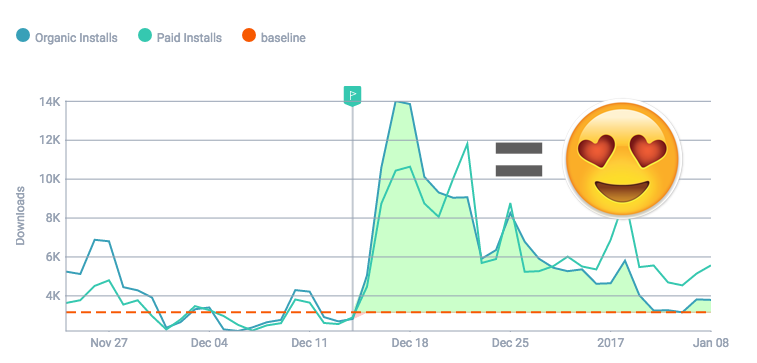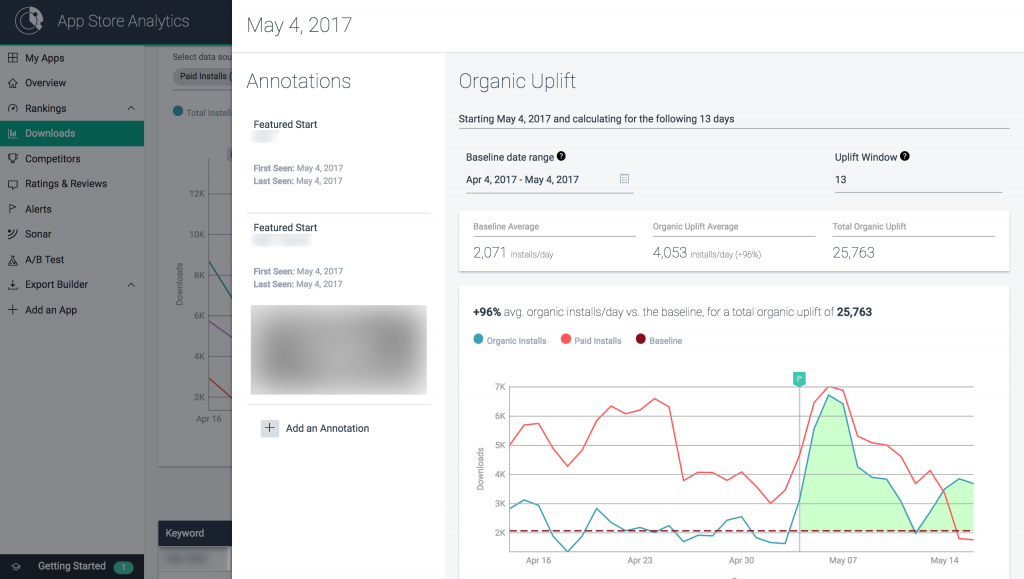
As marketers become more focused on acquiring the right customers, regardless of channel, acquisition paths and methods blur together. In parallel, marketing expertise and specialties on a team, like user acquisition, re-engagement, and retention, are melding.
This shift creates a stream of customers flowing into the top of the funnel, often being acquired by multiple marketing strategies, but without clear context and measurement as to how those strategies are helping — or hurting — each other.
Paid and organic user acquisition have this type of potentially symbiotic relationship, as Nicole Ramos, the mobile user acquisition manager at Electronic Arts, explained at Postback 2016:

We’ve done extensive analyses in the past investigating the paid and organic dynamic. On average, we found that for every paid install an app sees, it also sees 1.5 organic installs. At the tactical level, we’ve seen one company receive more than 80,000 organic installs than expected because of a successfully-executed paid campaign. Another firm saw over 115,000 organic installs come in because of the same. Why?
One explanation lies with the app store algorithms. Download velocity, the rate at which an app gets downloads over a certain time period, is an important factor in the app stores’ ranking algorithms. Essentially, the higher your velocity, the higher your rankings (in search and in Top Charts, generally). Of course, you need to be driving quality users, but those are the basic mechanics.
For example, if you run a campaign with a partner on a $200,000 budget and see 100,000 installs, you may also see 150,000 organic installs due to an increase in visibility. What was once a $2 CPI (cost per install) has now dropped by 60% to an effective CPI of 80 cents. All of a sudden that outlay looks much more palatable (well, depending on your revenue per user).
We’re opening up this type of analysis and measurement — and making it a whole lot easier — to TUNE Attribution Analytics clients with our new Organic Uplift Analysis solution as part of our App Store Analytics product. Fully integrated with your attribution data, Organic Uplift provides holistic measurement with rich context and saves you time.

What previously required exporting CSVs and living in Excel can now be completed in seconds. You have full flexibility over how you’d like to calculate your organic baseline, the duration of your uplift window, and what date you’d like to use as the start of your uplift window. Because this analysis hinges on a date — not an event — you can calculate uplift for any type of marketing (or marketing-impacting) effort, such as:
- Paid campaigns
- Being featured by the app stores
- App updates
- Conversion rate optimizations, like metadata changes
- Keyword optimizations
- Re-engagement campaigns
- App store algorithm changes, and
- Press mentions
We also firmly believe that data without context leads to less-actionable analyses. We’re working on automating as many annotations as possible to save you even more time (Featured placements are already automated for iOS, globally), but you can quickly create custom annotations and keep a history of what was done when and with what effect. This not only reduces the likelihood of repeating past mistakes, but it also increases the chances of identifying— and replicating— previous successes. As your team scales, it’ll have one place to go to get up-to-speed on what’s been done before.
Custom annotations are available for any TUNE App Store Analytics user at any plan— including our free tier.
If you’d like to learn more about Organic Uplift Analysis and you’re already a TUNE Attribution Analytics client, contact us or your Client Success Manager.
Author
Becky is the Senior Content Marketing Manager at TUNE. Before TUNE, she handled content strategy and marketing communications at several tech startups in the Bay Area. Becky received her bachelor's degree in English from Wake Forest University. After a decade in San Francisco and Seattle, she has returned home to Charleston, SC, where you can find her strolling through Hampton Park with her pup and enjoying the simple things in life.




Tune people, I like this article. But I am surprised you are missing a big big reason for organics installs.
Yes, paid installs are helping out organics. But it is not only because of increased visibility (in case the developer pays sh*t ton of money to be at top X charts), but also because of people who are talking about the apps they are using.
Hey Samet – Totally agree that word of mouth is a huge referral source. In research we’ve done (granted it was back in 2014), we saw word of mouth (from friends/family) contribute – on average – 15% of organic installs, which is likely on the conservative end.
The tricky bit here is measuring word of mouth because it typically comes in as organic. I think that if word of mouth is catalyzed by marketing efforts, this feature can help measure the impact of that. For example, if an app is covered in the press, or included in a viral narrative on a specific date or date range, that can be measured through this type of correlative analysis.
Our hope with this product update is to give marketers a flexible tool to measure all sorts of marketing efforts and how they impact organic installs, with paid campaigns being one particularly shining – though not exhaustive – example.